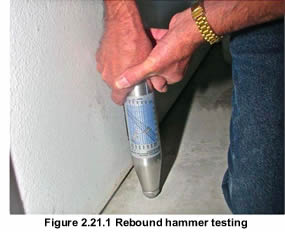

Webmaster: Stansfeld, LLC. |
|
|

AUGUST 2010 MEETING
Wednesday, August 11, 2010
TECHNICAL
PROGRAM
Test Methods for Evaluating Existing Foundations
Speaker: Al Bustamante, P.E., Member, with Wiss, Janney, Elstner Associates, Inc., Houston TX, Tel. Tel: 832-467-2177
Al Bustamante, is a Senior Associate with the Houston Office of Wiss, Janney, Elstner Associates (WJE). Mr. Bustamante has been involved with the evaluation, testing, and design repairs of foundations and parking structures, non-destructive testing of concrete structures, structural metal computer modeling and analysis, and exterior wall cladding evaluation and design repair. Mr. Bustamante is a Texas licensed professional engineer, a member of the American Concrete Institute (ACI), the American Institute of Steel Construction (AISC), and he chaired the Foundation Performance Association's Structural Subcommittee # FPA-SC-02, the subcommittee that authored the paper he is presented.
PRESENTATION SUMMARY
 To an audience of about 80 at the HESS Club, Mr. Bustamante presented the FPA's Structural Committee paper no. FPA-SC-02. The paper, titled "Test Methods for Evaluating Existing Foundations", encompasses current methods for testing of concrete foundations. The purpose of the document is to provide general guidelines for common types of test methods that may be used to evaluate existing foundations. The methods discussed in the paper are primarily intended for lightly loaded concrete foundations such as residential slabs on grade, light commercial concrete foundations, and concrete pavements.
To an audience of about 80 at the HESS Club, Mr. Bustamante presented the FPA's Structural Committee paper no. FPA-SC-02. The paper, titled "Test Methods for Evaluating Existing Foundations", encompasses current methods for testing of concrete foundations. The purpose of the document is to provide general guidelines for common types of test methods that may be used to evaluate existing foundations. The methods discussed in the paper are primarily intended for lightly loaded concrete foundations such as residential slabs on grade, light commercial concrete foundations, and concrete pavements.
Several years ago the FPA's Structural Committee recognized a need in the industry to produce a guide that could aid forensic engineers, forensic consultants and others in identifying appropriate test methods available for use in their evaluation of lightly loaded concrete foundations and pavements. The ad hoc subcommittee # FPA-SC-02 of ten engineers was formed in July 2007 to compile the comprehensive document. The committee plans to submit the paper into FPA peer review by the end of August 2010. If the paper passes peer review, it will be published on the FPA's website early October 2010.
Mr. Bustamante provided the background information on the development of the paper. He also provided insight to the process used to include and evaluate the different test methods available. A typical test method in the paper includes a general description of the method, the various applications possible for the method, some suggested considerations in order to properly use the method, the relative costs for buying or renting the necessary equipment or for hiring professional services that regularly use the method, and a list of standard references, mostly ASTMs, to read for proper application of the method.
During his presentation, Mr. Bustamante addressed each of the paper's 26 test methods ranging from simple tests such as ground probing, visual, and chain dragging to more sophisticated test methods such as ground penetrating radar, electrical resistivity testing, and impact echo. Some of these simpler methods are accepted or approved for use in a variety of ACI papers. The simplest methods, such as hammer sounding and carpenter level testing, have no backing by ASTM, ACI, or other standards. Other methods such as half cell potential, used to detect rebar corrosion, are highly technical and are best provided by specialists or labs.
Mr. Bustamante pointed out the final publication of the committee paper will include a useful summary table that cross references the test methods against the concrete characteristics and deficiencies, with the current version of this table being included in a handout. As an example for using the summary table, he demonstrated that if the forensic consultant wanted to obtain the thickness of a slab, the test methods available to him, depending on the situation, would be concrete coring, ground penetrating radar, probing, and inspection openings/ excavations.
In closing, Mr. Bustamante presented a case study of a Houston warehouse whose 6" slab had many different problems and required the use of several different test methods. More details of the case study can be found beginning at slide no. 43 of Mr. Bustamante's slides.
To download Mr. Bustamante's handout that includes excerpts of the paper he presented along with the complete summary table, click here
To download Mr. Bustamante's slide presentation, click here.
|



